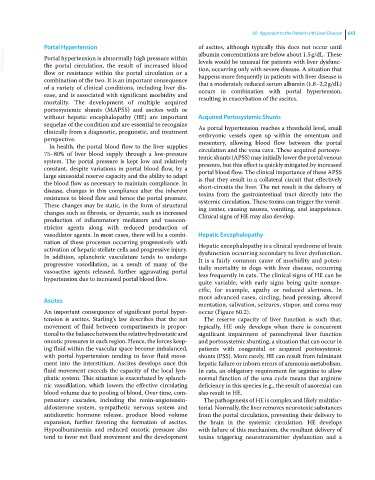Page 675 - Clinical Small Animal Internal Medicine
P. 675
60 Approach to the Patient with Liver Disease 643
Portal Hypertension of ascites, although typically this does not occur until
VetBooks.ir Portal hypertension is abnormally high pressure within albumin concentrations are below about 1.5 g/dL. These
levels would be unusual for patients with liver dysfunc-
the portal circulation, the result of increased blood
flow or resistance within the portal circulation or a tion, occurring only with severe disease. A situation that
happens more frequently in patients with liver disease is
combination of the two. It is an important consequence that a moderately reduced serum albumin (1.8–2.2 g/dL)
of a variety of clinical conditions, including liver dis- occurs in combination with portal hypertension,
ease, and is associated with significant morbidity and resulting in exacerbation of the ascites.
mortality. The development of multiple acquired
portosystemic shunts (MAPSS) and ascites with or
without hepatic encephalopathy (HE) are important Acquired Portosystemic Shunts
sequelae of the condition and are essential to recognize As portal hypertension reaches a threshold level, small
clinically from a diagnostic, prognostic, and treatment embryonic vessels open up within the omentum and
perspective. mesentery, allowing blood flow between the portal
In health, the portal blood flow to the liver supplies
75–80% of liver blood supply through a low‐pressure circulation and the vena cava. These acquired portosys-
temic shunts (APSS) may initially lower the portal venous
system. The portal pressure is kept low and relatively pressure, but this effect is quickly mitigated by increased
constant, despite variations in portal blood flow, by a portal blood flow. The clinical importance of these APSS
large sinusoidal reserve capacity and the ability to adapt is that they result in a collateral circuit that effectively
the blood flow as necessary to maintain compliance. In short‐circuits the liver. The net result is the delivery of
disease, changes in this compliance alter the inherent toxins from the gastrointestinal tract directly into the
resistance to blood flow and hence the portal pressure. systemic circulation. These toxins can trigger the vomit-
These changes may be static, in the form of structural ing center, causing nausea, vomiting, and inappetence.
changes such as fibrosis, or dynamic, such as increased Clinical signs of HE may also develop.
production of inflammatory mediators and vasocon-
strictor agents along with reduced production of
vasodilator agents. In most cases, there will be a combi- Hepatic Encephalopathy
nation of these processes occurring progressively with Hepatic encephalopathy is a clinical syndrome of brain
activation of hepatic stellate cells and progressive injury. dysfunction occurring secondary to liver dysfunction.
In addition, splanchnic vasculature tends to undergo It is a fairly common cause of morbidity and poten-
progressive vasodilation, as a result of many of the tially mortality in dogs with liver disease, occurring
vasoactive agents released, further aggravating portal less frequently in cats. The clinical signs of HE can be
hypertension due to increased portal blood flow.
quite variable, with early signs being quite nonspe-
cific, for example, apathy or reduced alertness. In
more advanced cases, circling, head pressing, altered
Ascites
mentation, salivation, seizures, stupor, and coma may
An important consequence of significant portal hyper- occur (Figure 60.2).
tension is ascites. Starling’s law describes that the net The reserve capacity of liver function is such that,
movement of fluid between compartments is propor- typically, HE only develops when there is concurrent
tional to the balance between the relative hydrostatic and significant impairment of parenchymal liver function
oncotic pressures in each region. Hence, the forces keep- and portosystemic shunting, a situation that can occur in
ing fluid within the vascular space become imbalanced, patients with congenital or acquired portosystemic
with portal hypertension tending to favor fluid move- shunts (PSS). More rarely, HE can result from fulminant
ment into the interstitium. Ascites develops once this hepatic failure or inborn errors of ammonia metabolism.
fluid movement exceeds the capacity of the local lym- In cats, an obligatory requirement for arginine to allow
phatic system. This situation is exacerbated by splanch- normal function of the urea cycle means that arginine
nic vasodilation, which lowers the effective circulating deficiency in this species (e.g., the result of anorexia) can
blood volume due to pooling of blood. Over time, com- also result in HE.
pensatory cascades, including the renin‐angiotensin‐ The pathogenesis of HE is complex and likely multifac-
aldosterone system, sympathetic nervous system and torial. Normally, the liver removes neurotoxic substances
antidiuretic hormone release, produce blood volume from the portal circulation, preventing their delivery to
expansion, further favoring the formation of ascites. the brain in the systemic circulation. HE develops
Hypoalbuminemia and reduced oncotic pressure also with failure of this mechanism, the resultant delivery of
tend to favor net fluid movement and the development toxins triggering neurotransmitter dysfunction and a

